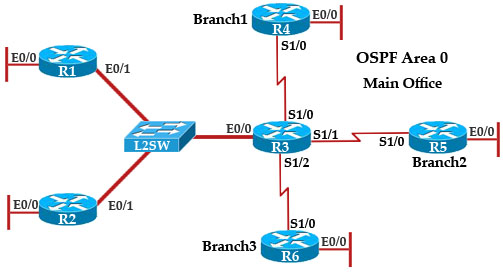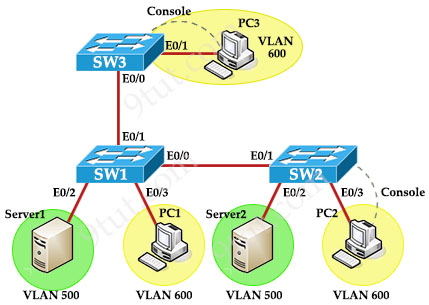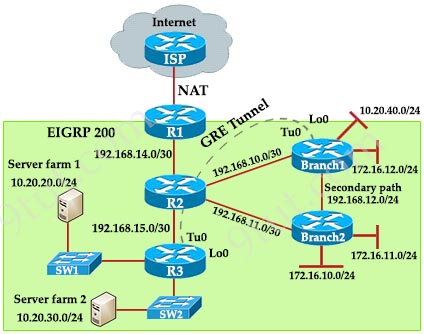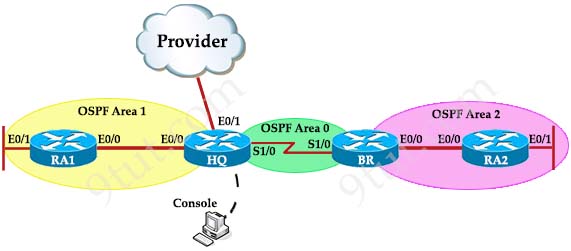OSPF Neighbor Sim
Question
The topology below is running OSPF. You are required to troubleshoot and resolve the OSPF issues between the various routers. Use the appropriate show commands to troubleshoot the issues.

Question
The topology below is running OSPF. You are required to troubleshoot and resolve the OSPF issues between the various routers. Use the appropriate show commands to troubleshoot the issues.

Refer to the exhibit.

Your colleague has built a Layer 2 network in your client locations. You must verify the configuration and fix any issues identified as per customer requirements.
Customer requirements:
+ Verify if switch ports are assigned correct VLANs as shown in topology. Identify and fix any misconfiguration found in three switches
+ Verify if trunk links are operational between switches and the IEEE 802.1Q trunk encapsulation method is used. Identify and fix any misconfiguration found in trunk configuration
+ Make sure ports connected between switches are set as trunk ports
Refer to the topology below. Your company asks you to identify the issues in Phase 1 EIGRP implementation. You have console access on R1, R2, R3 Branch1 and Branch2 routers. Only use show commands to troubleshoot the issues.

Question
All routers are running IPv6 OSPF with process ID 100. The loopback0 IPv4 address is the OSPF router ID of each router.
On HQ router, a provider link is provided and you have to configure an IPv6 default route on HQ and make sure this route is advertised in IPv6 OSPF process. Also troubleshoot why HQ is not forming IPv6 OSPF neighbor with BR.
Requirements:
1. Configure IPv6 default route on HQ router with default gateway of 2001:DB8:B:B1B2::1
2. Verify by pinging provider test IPv6 address 2001:DB8:0:1111::1 after configuring default route on HQ
3. Make sure that the default route is advertised in IPv6 OSPF router HQ. This default route should be advertised only when HQ has a default route in its routing table
4. Router HQ is not forming IPv6 OSPF neighbor with BR. Troubleshoot and solve the problem
Special Note: To gain the maximum number of points, you must complete the necessary configurations and fix IPv6 OSPF neighbor issue with router BR. IPv6 OSPFv3 must be configured without using address families. Do not change the IPv6 OSPF process ID.

Question
The topology below is running EIGRP. You are required to troubleshoot and resolve the EIGRP issues between the various routers. Use the appropriate show commands to troubleshoot the issues.
Question
Refer to the topology below, you are only allowed to access the CLI of Sw-AC3 to answer some questions. This does not require any configuration.

Well, the title said it all. Here are some screenshots about the labs in Packet Tracer Simulator:

Question
Your company has just added R3 router to the existing network. But currently no routing updates are being exchanged between R3 and the network. All other connectivity, including Internet access are working properly.
The task is to identify the fault(s) and correct the router configuration to provide full connectivity between the routers.
All passwords on all routers are set to cisco.
IP addresses are listed in the chart below.

| R1 Fa0/0: 192.168.77.33 S1/0: 198.0.18.6 S0/1: 192.168.60.25 S0/0: 192.168.36.13 |
R2 Fa0/0: 192.168.60.97 Fa0/1: 192.168.60.113 S0/0: 192.168.36.14 |
| R3 Fa0/0: 192.168.77.34 Fa0/1: 192.168.60.65 Fa1/0: 192.168.60.81 |
R4 Fa0/0: 192.168.60.129 Fa0/1: 192.168.60.145 S0/1: 192.168.60.26 |
Answer and explanation
Question
Refer to the topology

TUT Company recently installed a new router in their office. Complete the network installation by performing the initial router configurations and configuring RIPv2 routing using the router command line interface (CLI) on the R2-TUT.
Name of the router is R2-TUT
Enable-secret password is cisco1
The password to access user EXEC mode using the console is cisco2
The password to allow telnet access to the router is cisco3
IPV4 addresses must be configured as follows:
Ethernet network 213.123.20.128/27 – router has last assignable host address in subnet
Serial network is 200.0.1.16/28 – router has last assignable host address in the subnet. Interfaces should be enabled.
Router protocol is RIPv2
Solution
Question
You are tasked to configure Internet access on a router. The ISP has provided the company six public IP addresses of 198.18.184.105 198.18.184.110. The company has 14 hosts that need to access the internet simultaneously. The hosts in the company LAN have been assigned private space addresses in the range of 192.168.100.17 – 192.168.100.30.
|
The following have already been configured on the router: – Router basic configuration |
Tasks:
+ Use NAT to provide Internet access to all hosts in the company LAN.
+ Name the router TUT
+ Inside global addresses: 198.18.184.105 198.18.184.110/29
+ Inside local addresses: 192.168.100.17 – 192.168.100.30/28
+ Numer of inside hosts: 14

Solution